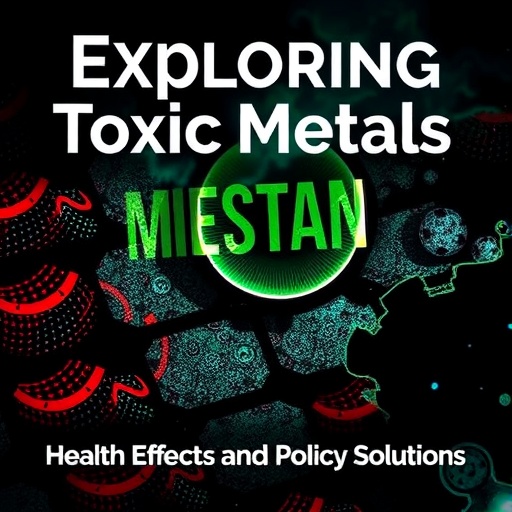The Institute and Clinic for Occupational, Social and Environmental Medicine at the LMU Munich Hospital, in collaboration with the Collegium Ramazzini, is set to host an ambitious international symposium focusing on the pervasive and complex issue of toxic metals and their multifaceted impacts on human health and global policy. Scheduled to take place on July 4 and 5, 2025, at the St.-Vinzenz-Haus within the prestigious LMU Hospital City Campus, this two-day event promises to gather over 40 leading scientists from more than 20 countries, fostering a dynamic platform for cutting-edge presentations, interdisciplinary discussions, and policy deliberations regarding exposure to toxic metals and the urgent need for systemic interventions.
Toxic metals such as lead, mercury, cadmium, and arsenic have long been recognized as pervasive environmental pollutants with significant implications for human health. Recent advances in biomonitoring techniques, including innovative microsampling methods, allow for unprecedented precision in assessing individual and population-level exposure to these hazardous substances. This symposium will feature comprehensive sessions on environmental and human biomonitoring, showcasing how refined analytical tools enable researchers to track bioaccumulation and exposure pathways with greater sensitivity, thereby establishing more robust links between metal exposure and adverse health outcomes.
Health effects arising from toxic metal exposure form a core focus of the symposium, with a deep dive into emerging evidence connecting specific metals to an array of severe diseases. Foremost among these are cancer risks — with particular attention to how chronic exposure to certain metals can initiate or promote carcinogenesis through mechanisms involving oxidative stress, DNA damage, and epigenetic modifications. Beyond oncological concerns, metal exposure also detrimentally impacts the cardiovascular system and cognitive health, contributing to an increased prevalence of cardiovascular diseases and neurodegenerative disorders worldwide.
Adopting a truly global perspective, the symposium will address case studies across Africa, Asia, and Europe, highlighting disparate sources of metal contamination such as artisanal mining, electronic waste recycling, and food adulteration — notably the contamination of spices with lead. These geographically diverse investigations reveal how socioeconomic factors and industrial practices intersect to exacerbate metal exposure in vulnerable populations. Moreover, the discussions will encompass promising developments in sustainable battery technology, foregrounding the necessity of balancing technological advancement with environmental stewardship and human health considerations.
The prevention and risk minimization segment of the symposium represents a pivotal moment for bridging science and policy. Through a dedicated Science-Policy Panel, experts will evaluate existing regulatory frameworks and advocate for evidence-based measures to reduce exposure and mitigate health risks. Emphasis will be placed on crafting policies that are both scientifically rigorous and socially equitable, addressing the complex challenge of implementing effective controls across diverse socioeconomic and geopolitical contexts.
A distinctive feature of the event is its commitment to nurturing the next generation of scientists. The symposium includes a vibrant e-poster session where young researchers will present novel findings and innovative methodologies. This initiative not only facilitates the dissemination of fresh ideas but also fosters mentorship and global collaboration, essential components for sustaining progress in the rapidly evolving field of environmental health sciences.
The hybrid nature of the symposium—facilitating participation both onsite in Munich and virtually worldwide—ensures wide accessibility, encouraging a diverse array of contributions and broad dissemination of knowledge. This format acknowledges the importance of inclusivity in shaping a global response to the pressing challenges posed by toxic metals and environmental contamination.
Scientific discussions at the symposium delve into the molecular and cellular pathways affected by toxic metal exposure. Metals such as cadmium and mercury induce oxidative stress by generating reactive oxygen species, leading to lipid peroxidation, mitochondrial dysfunction, and subsequent cell death. Chronic exposure also triggers inflammatory responses, alters gene expression patterns, and disrupts endocrine function, cumulatively increasing susceptibility to chronic diseases. Understanding these mechanisms is crucial for developing targeted therapeutic interventions and preventive strategies.
Moreover, advanced biomonitoring techniques including microsampling permit minimally invasive collection of biological specimens such as blood, urine, and hair, enabling longitudinal studies with reduced participant burden. These methodologies enhance the temporal resolution of exposure assessments, capturing dynamic changes and enabling early detection of toxic insults. Such granularity in exposure data is instrumental for establishing dose-response relationships and refining risk assessment models.
The interdisciplinary nature of the symposium also encompasses environmental justice considerations. Many affected communities reside in regions burdened with inadequate infrastructure, limited regulatory oversight, and economic dependencies on polluting industries. Addressing toxic metal exposure requires integrating scientific findings with sociopolitical strategies that empower communities, promote safe work environments, and ensure equitable access to healthcare and remediation resources.
Sustainability also occupies a central theme, with discussions examining the lifecycle of metals from extraction to disposal. Particularly, the symposium will critically assess the environmental footprint of emerging battery technologies, evaluating how the shifting demand for metals intersects with the dual imperatives of clean energy and human health protection. Innovations in recycling, substitution of hazardous metals, and green chemistry principles are explored as pathways toward reducing the overall toxic burden.
Given the diverse expertise of participants spanning toxicology, epidemiology, environmental science, and policy, the event is poised to catalyze significant advancements in comprehending and combating the health impacts of toxic metals. The convergence of empirical research, technological innovation, and policy discourse underscores the urgent need for a coordinated global response to this pressing public health challenge.
Ultimately, the Toxic Metals Symposium at LMU Munich epitomizes a comprehensive effort to illuminate one of the most insidious environmental health threats of our time. By uniting a global network of researchers, policymakers, and emerging scientists, the symposium sets the stage for transformative insights and actionable strategies aimed at safeguarding human health from the silent yet profound dangers posed by toxic metals.
Subject of Research: Toxic Metals and Their Health Impacts
Article Title: Toxic Metals Symposium 2025: Advancing Global Understanding and Policy Action on Environmental Contamination
News Publication Date: Not specified (Event date: July 4-5, 2025)
Web References: Not provided
References: Not provided
Image Credits: Not provided
Keywords: Toxic metals, biomonitoring, health effects, environmental contamination, policy measures, cancer risk, cardiovascular disease, cognitive impairment, global health, sustainable technology, heavy metals, environmental justice




